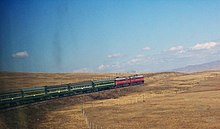Gobi or Govi is a region in Mongolia that covers the Gobi Desert in Mongolia.
Cities
[edit]- 1 Altai is the capital of Govĭ-Altai province.
- 2 Bayanhongor is home to the Govi Bear, sand dunes, and some nice oases.
- 3 Dalanzadgad , quickly becoming the richest town in Mongolia, is a starting point for exploring the Red Hills.
- 4 Mandalgovĭ is the capital of Dundgovĭ province.
- 5 Sainshand is growing industrial city with a large monastery.
- 6 Zamiin-Uud (Zamyn-Üüd) is the main border crossing with China, and a stop on the Trans-Mongolian Railway.
Other destinations
[edit]
Understand
[edit]
The Gobi Desert covers the bottom third of Mongolia and has quite a lot to offer for most travelers to Mongolia. It is one of the largest desert regions in Asia and has long served as a buffer between the Mongolian steppe and China. It is also the world's coldest desert. The climate is drier and slightly warmer than the rest of Mongolia, but still frigid in winter. Thus, travel here even into September and October is not unheard of for tourists.
Sand storms are common in the spring, and it is joked that Mongolia's oldest export to China is dust from the Gobi. It is not uncommon for provincial schools to close, due to dust storms. Most Mongols tie weights around their gers during the spring to support the home during the dust storms.
The Great Wall of China follows the southern boundary of the desert. The desert's dry cold weather has made it one of the best places in the world for finding dinosaur bones. For any related Gobi Travel, the best start is Dalanzadgad, the provincial capital of South Gobi province within which lie most of the Gobi's attractions.
Get in
[edit]It is possible to fly to Altai, Bayanhongor, and Dalanzadgad on one of the domestic airlines from Ulaanbaatar. Sainshand lies on the Trans-Mongolian Railway and can be reached by train. All parts of the region can be reached by bus from UB, however only Sainshand and Bayanhongor have paved roads connecting to the capital.
Get around
[edit]Hiring a private driver is essentially the only option. Call local hotels and ask, go on social media, reach out. Expect things to not go as planned. Tourism infrastructure in Mongolia is not yet developed (as of 2021), relative to other countries. Fuel is relatively expensive. A driver's fee can be 50-75 USD a day, and you must feed him and lodge him. Wherever you stay, there will likely be a discount for the driver's lodging.

See
[edit]Do
[edit]Go to South Gobi and see the flaming cliffs, the singing sand dunes, and the ice canyon.
Eat
[edit]Camel meat. Not bad, from most visitor's perspectives. Nothing special, but a memory will suffice
Drink
[edit]Camel milk. Not bad, not great. 4-10% alcohol perhaps. Causes constipation.
Stay safe
[edit]The Gobi can be quite hot, and the range of temperature between the sunny areas and the shade is tremendous. Keep this in mind and take more than enough water. Make sure your car has more than enough petrol, and you have plenty of water, food, torches, batteries, and trustworthy people.
Go next
[edit]Go to Elsen tasarkhai.


